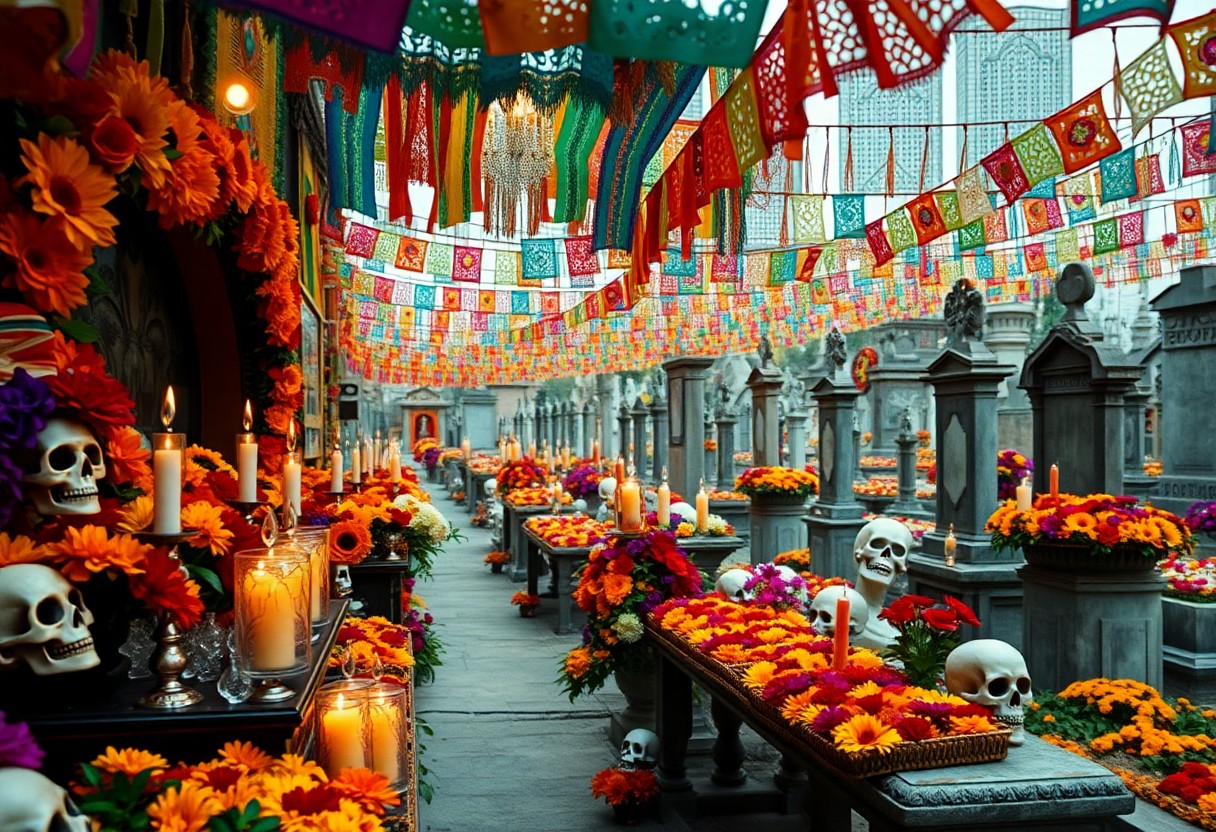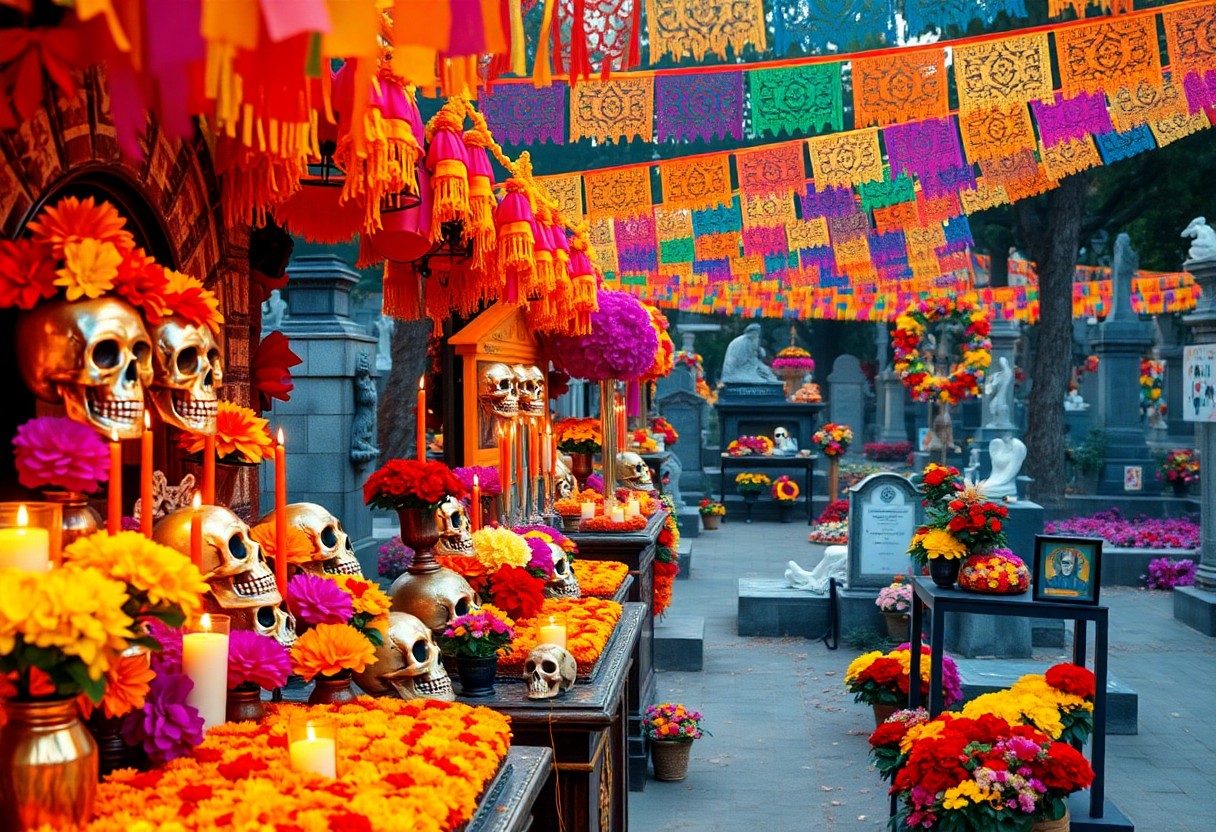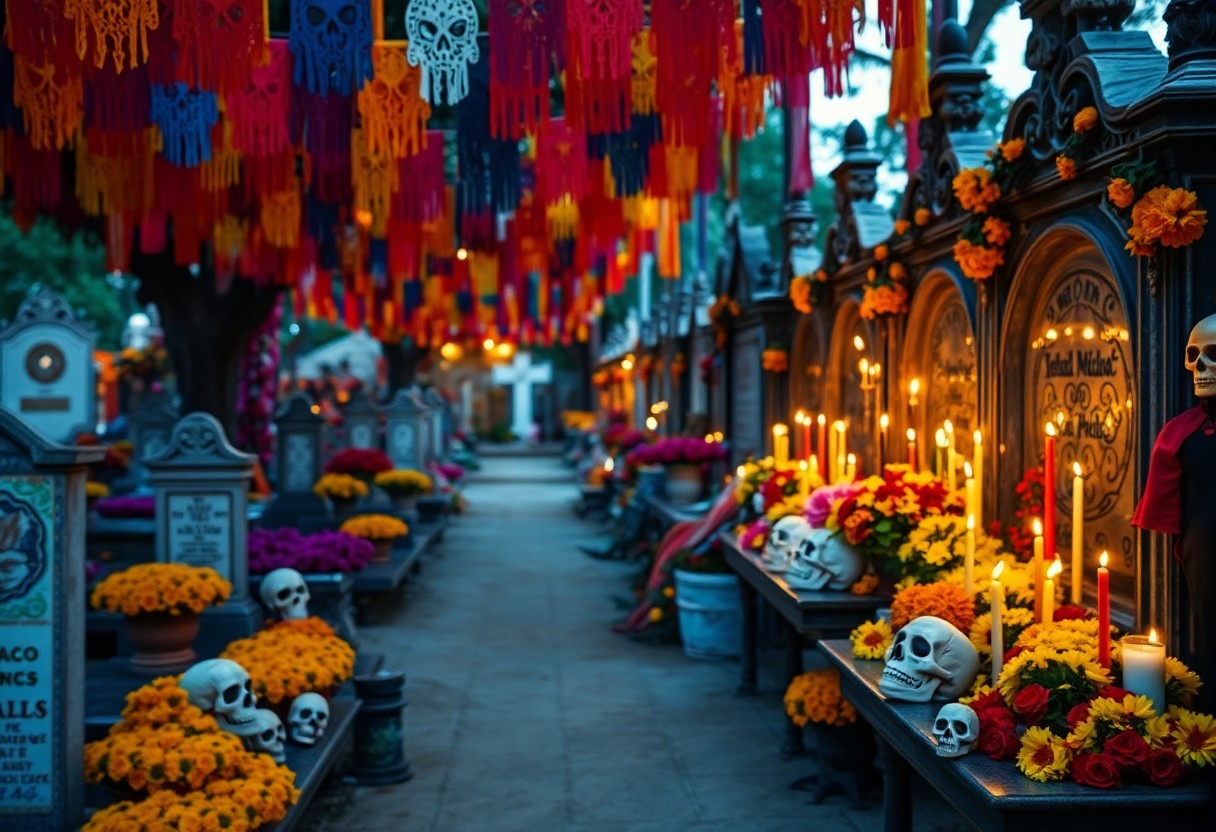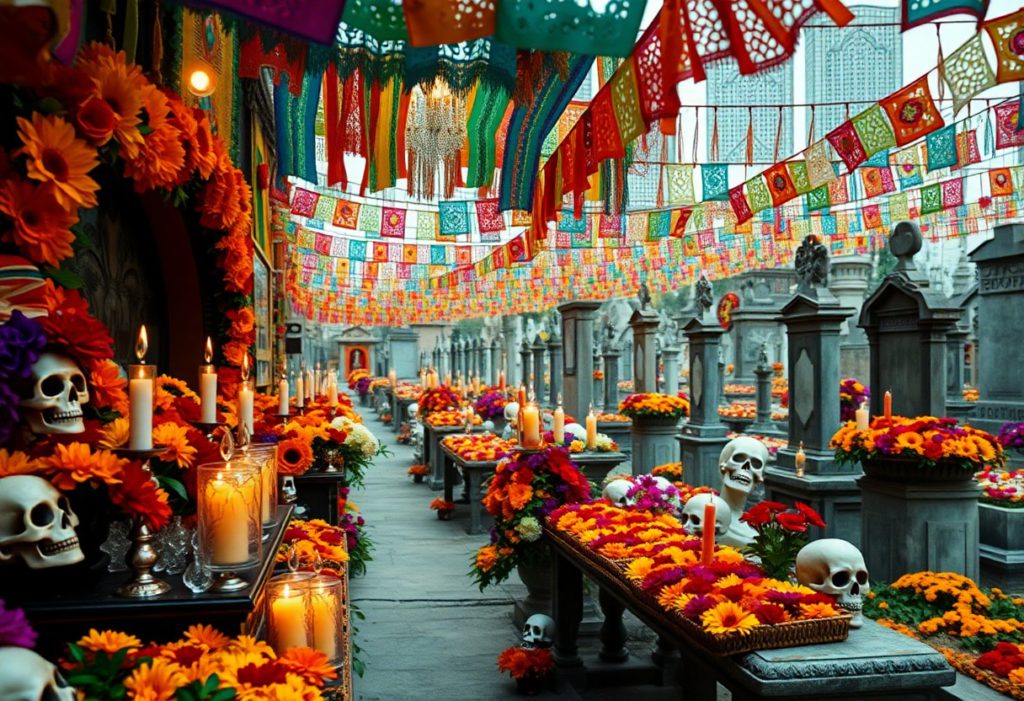In numerous cultures around the world, discussions about death are often avoided, deemed a taboo topic; however, in San Miguel de Allende, the perception of death is strikingly different. Here, death is embraced and celebrated through vibrant colors, rich traditions, and joyful remembrance. During the Day of the Dead, one can witness streets adorned with bright marigolds, families uniting to honor their departed loved ones, and beautifully crafted altars overflowing with meaningful offerings. This celebration transcends sorrow; it represents the acceptance of death as an integral aspect of life’s journey. In San Miguel de Allende, attendees can experience a captivating fusion of ancient rituals and modern festivities, making it a must-visit destination to delve into this profound cultural tradition that cherishes both life and memory.

Uncover the Fascinating Origins of the Day of the Dead Celebration
Long before the Spanish colonization, the Day of the Dead (Día de los Muertos) was steeped in ancient Mesoamerican traditions. The indigenous peoples, particularly the Aztecs, honored their ancestors through a month-long festival in the Aztec calendar month of Miccailhuitontli, dedicated to the goddess Mictecacihuatl, revered as the “Lady of the Dead.” These rituals highlighted the cyclical relationship between life and death, establishing a profound foundation for the modern celebration that continues to resonate with people across the globe today. This rich history forms an essential part of the cultural identity that beautifully intertwines with contemporary practices.
Delve Into the Time-Honored Traditions of Ancient Cultures
For over 2,500 years, indigenous communities in Mexico have engaged in sacred rituals to honor their ancestors who have passed away. These deep-rooted traditions feature offerings of food, aromatic flowers, and incense, symbolizing the everlasting bond between the living and the deceased. The Aztecs believed that death marked not an end but a transition into another realm of existence. This perspective significantly influences the essence of the Day of the Dead today, where the emphasis is on celebrating life together with those who have moved on to the afterlife, fostering a sense of continuity and remembrance.
Examine the Impact of Spanish Colonization on Day of the Dead Practices
The arrival of Spanish colonizers in the 16th century brought significant transformations to the Day of the Dead celebration. The Catholic Church integrated indigenous customs with the observances of All Saints’ Day (November 1st) and All Souls’ Day (November 2nd), condensing what was once a month-long celebration into a two-day event. This remarkable blending of cultures created a modern version of the holiday that intricately weaves pre-Hispanic traditions with Catholic influences, resulting in a unique expression of culture that honors both indigenous heritage and religious faith.
This cultural amalgamation introduced vibrant new elements, such as the prominent use of marigold flowers and the creation of ofrendas (altars), which have become central to the celebration. Although the Spanish aimed to suppress indigenous customs, the resilience and vibrancy of these traditions have ensured their survival, culminating in a rich cultural tapestry. Today, the Day of the Dead in San Miguel de Allende beautifully reflects this illustrious history, providing a vibrant and deeply meaningful experience for both locals and visitors.
Explore the Profound Significance of the Day of the Dead Celebration
One of the most profound aspects of the Day of the Dead is its focus on celebrating life rather than mourning death. In San Miguel de Allende, this unique tradition transforms grief into a festive occasion, with families honoring their deceased loved ones through colorful altars, uplifting music, and heartfelt offerings. The belief that the spirits of the departed return to partake in the festivities fosters a spiritual reunion that is both uplifting and profoundly meaningful. This unique viewpoint on death, rooted in ancient Mesoamerican and Catholic traditions, enriches the Day of the Dead experience, making it a celebration filled with emotion and reverence.
Uncover the Heartfelt Significance of Ofrendas in Day of the Dead Celebrations
The ofrendas, or altars, serve as the centerpiece of the Day of the Dead festivities in San Miguel de Allende. These intricately designed altars are adorned with vibrant marigold flowers, flickering candles, treasured photographs, and the favorite foods and beverages of the departed. The ofrendas symbolize a welcoming space for the spirits, representing love, remembrance, and connection. By meticulously creating these altars, families ensure that the memory of their loved ones is preserved, beautifully blending tradition with personal sentiment and heartfelt expressions.
Witness the Evolution of Day of the Dead Celebrations Over Time
As time advances, the Day of the Dead celebration in San Miguel de Allende has gracefully incorporated modern influences while remaining true to its rich roots. While some urban areas may adopt elements reminiscent of Halloween, the core essence of honoring the deceased remains unchanged. The celebration’s growing popularity has attracted visitors from around the world, who come to experience its unique blend of tradition, culture, and festivity, creating an unforgettable experience.
The influence of globalization has led to an increased international recognition of the Day of the Dead, resulting in a fascinating mix of cultural influences. In San Miguel de Allende, this evolution has presented both opportunities and challenges. While the festival’s rising popularity has significantly boosted tourism, there are ongoing concerns regarding the preservation of its authenticity. Despite these changes, the community remains firmly committed to maintaining the sacred and joyful spirit of the celebration, ensuring that it continues to honor the deceased with utmost respect and reverence.

Understanding Mexico’s Unique Perspective on Life and Death
Mexico’s relationship with death stands in stark contrast to many other cultures worldwide. Here, death is perceived not as an end but as a natural continuation of life, a viewpoint deeply entrenched in indigenous customs and Catholic beliefs. During the Day of the Dead, this perspective is celebrated with vibrant colors, lively music, and joyful remembrance, transforming what might be somber elsewhere into a vibrant tribute to life. In San Miguel de Allende, the festivities are particularly vivid, featuring ofrendas (altars) adorned with marigolds, photographs, and offerings that invite the spirits of loved ones to return home. Here, death is welcomed with open arms rather than feared, creating a one-of-a-kind cultural experience that is truly unparalleled.

Distinguishing Between Day of the Dead and Halloween: Two Unique Celebrations
While both the Day of the Dead and Halloween share themes of death and skeletons, they diverge significantly in their approach and meaning. The Day of the Dead, or Día de los Muertos, is a joyful celebration centered around honoring deceased loved ones and is deeply rooted in Mexican culture. In contrast, Halloween represents a festival of spooky fun with origins in Celtic traditions, primarily focusing on fear and mystery. While Halloween emphasizes eerie themes, the Day of the Dead highlights remembrance and celebration of life, providing a richer emotional experience.
Investigating the Origins of Both Celebrations
The Day of the Dead traces its origins back over 3,000 years to ancient Mesoamerican civilizations such as the Aztecs, who honored the goddess Mictecacihuatl during their sacred rituals. Following Spanish colonization, these traditions blended with Catholic holidays, specifically All Saints’ Day and All Souls’ Day, resulting in the modern celebration recognized worldwide today. Conversely, Halloween originated as the Celtic festival of Samhain, marking the thin divide between the living and the dead, which was later adapted by the Church.
Understanding the Purpose and Significance of Each Celebration
The Day of the Dead serves as a time for families to celebrate the lives of their departed loved ones, embracing the reality of death as a natural part of life’s journey. Families create ofrendas (altars) decorated with marigolds, photographs, and favorite foods, inviting spirits back into their homes. In contrast, Halloween is characterized by fun and fright, featuring costumes, trick-or-treating, and spooky themes where entertainment often takes precedence over reflection.
Moreover, the Day of the Dead possesses a deeply spiritual essence, emphasizing reconnection with ancestors and honoring their legacy. It provides families with an opportunity to gather, share stories, and celebrate the continuity of life. In comparison, while Halloween offers entertainment, it lacks the profound cultural and emotional depth that the Day of the Dead embodies.
Comparing Traditions and Activities of Both Celebrations
In San Miguel de Allende, the vibrant traditions of the Day of the Dead come alive through ofrendas, lively parades, and families adorning graves with marigolds. Participants often dress up as Catrinas or skeletons, while sharing traditional foods like <a href=”https://fallinginlovewithsanmiguel.com/top-5-reasons-to-retire-in-san-miguel/”>pan de muerto</a> among friends and family. Conversely, Halloween festivities generally include trick-or-treating, pumpkin carving, and costume parties heavily influenced by American culture.
Halloween celebrations in San Miguel de Allende are more prevalent among expatriates and urban locals, while the Day of the Dead remains a deeply rooted tradition cherished by many Mexican families. The city’s celebrations beautifully blend solemn remembrance with lively festivities, creating a unique and rich experience that cannot be replicated elsewhere.
Immerse Yourself in the Vibrant Celebrations of San Miguel de Allende
Despite its colonial charm, San Miguel de Allende transforms into a lively epicenter of activity during the Day of the Dead. Visitors will find streets overflowing with vibrant marigold flowers, intricate papel picado, and families gathering to honor their loved ones. The city hosts lively parades, where locals don costumes as Catrinas and skeletons, merging tradition with artistic expression. You can explore exquisitely crafted ofrendas in public areas, each telling a poignant story of remembrance. While the celebration is filled with joy, it’s essential to respect the sacred nature of the event, particularly in cemeteries where families come together privately to honor the lives of their loved ones.
Unraveling the Unique Traditions of the Day of the Dead
For centuries, Day of the Dead traditions in San Miguel de Allende have seamlessly blended indigenous and Catholic influences, resulting in a vibrant celebration that honors both life and death. Families can be seen constructing ofrendas (altars) adorned with photographs, candles, and favorite foods of the departed. The streets come alive with marigolds, calaveras (decorated skulls), and papel picado (perforated paper banners). These cherished customs serve as a powerful tribute to loved ones, inviting their spirits to return and celebrate alongside the living. The atmosphere is filled with joy, music, parades, and communal gatherings that reflect Mexico’s embrace of death as an essential part of life’s journey.
Understanding the Importance of Alfeñiques and Papel Picado in the Celebration
Integral to the Day of the Dead festivities, alfeñiques are intricate sugar sculptures crafted to resemble skulls, animals, or other figures. These delightful creations symbolize the sweetness of life and are often personalized with the names of the deceased. Complementing these edible masterpieces, papel picado—delicately cut tissue paper banners—adds a burst of color and movement to the celebrations. The perforations in the paper are believed to guide spirits to the ofrendas, while the vibrant designs serve as a poignant reminder of the fleeting nature of life.
Unveiling the Significance of Marigolds and Calaveras in Celebrations
If you visit San Miguel de Allende during the Day of the Dead, you’ll find yourself enveloped in the striking orange hues of marigolds, known as cempasúchil. These flowers are believed to guide spirits back home with their bright colors and fragrant aroma. Alongside them, calaveras (decorated skulls) are ubiquitous—adorning altars, appearing in parades, and even serving as face paint. These whimsical and colorful skulls embody the playful acceptance of death that is prevalent in Mexican culture.
A deeper exploration of marigolds and calaveras reveals their significant cultural meaning. Marigolds serve not merely as decoration; their petals create paths leading to ofrendas, ensuring that spirits can find their way home. Calaveras, whether crafted from sugar, clay, or painted on faces, remind us that death is not to be feared but embraced. In San Miguel de Allende, these elements come together to create a visually stunning and spiritually meaningful experience, honoring the life-death cycle in a manner that is both joyful and respectful.
Cherishing Life and Memory in San Miguel de Allende
From a broader perspective, experiencing San Miguel de Allende during the Day of the Dead provides a profound opportunity to embrace death through its vibrant celebrations. You will witness a captivating blend of ancient traditions and modern expressions, where families honor their loved ones with colorful altars, marigold flowers, and joyful gatherings. The city’s streets come alive with parades, papel picado, and the enticing aroma of pan de muerto, inviting you to immerse yourself in a cultural perspective that views death as a natural part of life. In San Miguel de Allende, you don’t merely observe the Day of the Dead—you feel its spirit, celebrating life and memory in an authentically Mexican manner.
Your Guide to Common Questions About the Day of the Dead
Q: What makes San Miguel de Allende a distinctive and memorable location to celebrate the Day of the Dead?
A: San Miguel de Allende is celebrated for its vibrant and authentic Day of the Dead festivities. The city masterfully blends traditional Mexican customs with local elements, resulting in elaborate parades, colorful altars, and heartfelt community gatherings. The historic streets and colonial architecture provide a picturesque backdrop for the celebrations, creating a memorable experience for all who visit.
Q: What are the primary traditions associated with the Day of the Dead in San Miguel de Allende?
A: Key traditions encompass the creation of ofrendas (altars) adorned with beautiful marigold flowers, cherished photographs of the deceased, and their favorite foods. Families engage in cleaning and decorating graves, and many participants don costumes as skeletons or Catrinas. The city also hosts lively parades, live music, and cultural performances, offering a unique blend of solemn remembrance and joyful celebration.
Q: How can visitors engage respectfully in Day of the Dead celebrations in San Miguel de Allende?
A: Visitors should approach the celebrations with respect and cultural sensitivity. It’s advisable to avoid intrusive photography in cemeteries, as these spaces hold deep significance for families. Participating in public events like parades and workshops is encouraged, along with gaining a deeper understanding of the traditions beforehand. Supporting local artisans by purchasing handmade crafts or traditional foods is also a meaningful way to engage with the culture.
The Article: Day of the Dead: A Unique Way to Embrace Death in San Miguel de Allende appeared first on https://fallinginlovewithsanmiguel.com/
The Article Embrace Death: Discover Day of the Dead in San Miguel de Allende Was Found On https://limitsofstrategy.com



It’s so refreshing to see a place like San Miguel de Allende embrace death in such a vibrant way. I often find that our modern society tends to shy away from conversations about death, treating it as something to be feared or avoided. Yet, the way you’ve described the Day of the Dead celebration really highlights an essential truth about life: death is a part of our journey, and acknowledging that can lead to a deeper understanding of what it means to live fully.
I really appreciate how you highlighted the unique way San Miguel de Allende embraces death in such a vibrant and meaningful manner. It’s fascinating to see how cultures find ways to celebrate life through the remembrance of those who have passed. This reminds me of how different societies deal with grief; for instance, some Eastern cultures hold ancestor worship as a way to stay connected with loved ones who have died.
I find that connection between life and death in cultures like that of San Miguel de Allende quite profound. The way they celebrate death as part of life feels almost like a reminder to cherish our memories rather than shy away from them. You mentioned ancestor worship in some Eastern cultures, which is another beautiful practice that emphasizes familial bonds and remembrance. It’s intriguing how different societies navigate grief and loss, each finding their own way to incorporate those experiences into their daily lives.
It’s truly intriguing how different cultures approach the topic of death and remembrance. The way San Miguel de Allende celebrates it really stands out, turning what could be a somber occasion into a festive one filled with color and joy. It’s almost as if the community is reminding everyone that life and death are both parts of a larger cycle, and we can honor our loved ones while also continuing to celebrate our own lives.
It’s interesting how these cultural practices shine a light on our shared human experience. In San Miguel de Allende, the celebration of death feels almost like a community gathering, allowing people to reflect on their loved ones while still embracing joy. It is a reminder that grief and celebration can coexist.